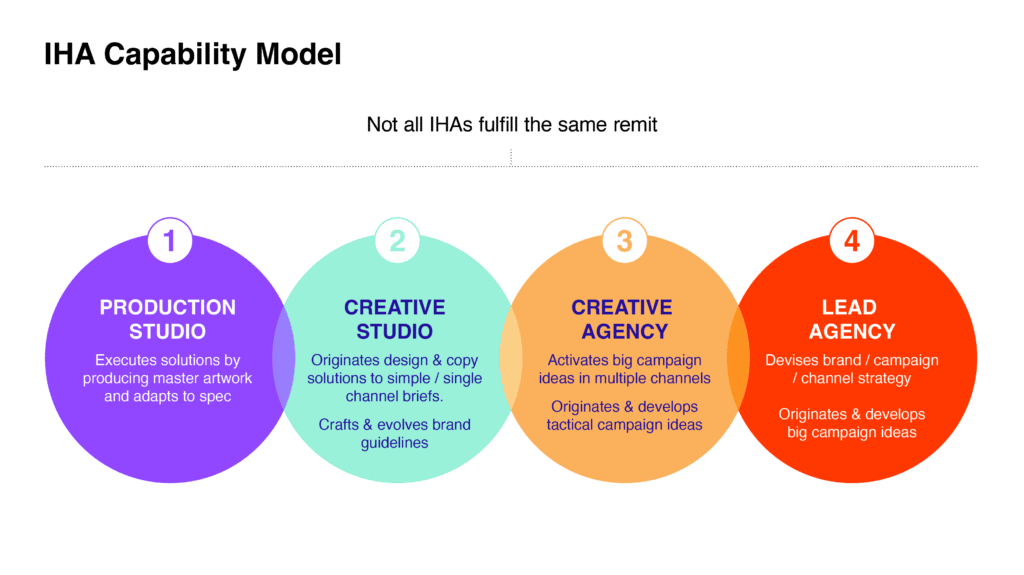There are four main models for in-house agencies: understanding which one is right for your business is key, says WDC‘s John Owen
In-house agencies tend to start out life as some sort of studio. As they prove their worth, they often then seek to evolve into something more strategic. Navigating this journey is not always easy.
Knowing where you are on the journey is not always obvious. And conceiving of it as a journey is not always wise.
Here’s our handy guide to the four types of IHA we tend to encounter most in our work at WDC. See it as a journey if you like, but, more importantly, use it to work out what you are right now, and what this means for the way you are set up.
Being clear about your remit is a pre-requisite for success, in our experience. Your remit determines your talent needs and informs your ways of working. The four remits we encounter most can be categorised as follows:

PRODUCTION STUDIO
In general, a Production Studio executes solutions. It doesn’t originate ideas, designs or copy, but it takes these and turns them into assets that are ready to run in whatever channel and format is required. It may be dedicated to certain channels or formats, or it may be capable of producing a wide variety of outputs.
Talent needs
It’s unlikely that a Production Studio would need conceptual creative or strategic talent. Core skills are strong operations people with both production and project management skillsets, artworkers, executional designers, retouchers, QA and potentially some motion graphics, photography and videography capabilities.
Operating model
Briefs will be functional and directional, reviews will focus on executional detail rather than reworking any of the concepts, designs or copy, all of which should be finalised before the Production Studio is briefed.
CREATIVE STUDIO
A Creative Studio may contain all the capabilities of a Production Studio (or it may outsource these services). What distinguishes it is the ability to originate design and copy led solutions, usually in response to relatively contained, single-channel briefs.
The briefs might focus on print materials for retail environments, packaging or events; the design of specific web pages, emails or social content; or the creation of simple videos or animations. Some creative studios can work across all of these channels and formats, some are more specialised.
Often they own and evolve the brand guidelines.
Talent needs
In keeping with the above requirements, Creative Studios need conceptual creative talent – such as copywriters, conceptual designers, motion designers and filmmakers.
Operating model
Briefs will define a problem to be solved, a message to communicate, or a mood to be evoked.
Creative development will be required, with options being developed, feedback being sought and managed so that the right solutions can be identified and finessed.
CREATIVE AGENCY
The distinction between a Creative Studio and a Creative Agency is the ability to conceive and extend multi-channel ideas – whether this be campaign ideas or content programmes that require distribution across different platforms. Either way, the essential skill required is storytelling.
Talent needs
This is where strategic planning becomes vital – both to write single-minded, inspirational creative briefs and to map out communications and content calendars into which these individual briefs fit.
And, of course, you need creatives – whether it’s the classic copywriter-art director teams for advertising and promotional work, or journalists and writer-directors for content work. The key factor is their ability to both originate an idea and conceive how to activate in multiple channels, across different platforms, in a variety of formats.
The stronger and more proven the capabilities, the more likely it is that an in-house Creative Agency will be given a remit to originate entire campaigns and content programmes on its own. On big campaigns, however, it will more likely be responsible for activation – working in partnership with an external agency to iterate their ‘big idea’ across multiple channels. This might involve adaptations for use in a physical store environment, or on the website; or it could involve extending the idea in new ways, via stories told in social media channels, or within email loyalty programmes, or via PR.
Operating model
In an ideal world, the in-house agency is tightly integrated with the external agency – briefed at the same time, invited to early tissue sessions and seen as a contributor of ideas. As the chosen idea develops into multiple iterations, the agency’s creatives will work with specialists (of the sort founding a creative studio) to craft and finalise channel-specific solutions. Whereupon it can be briefed into a production studio for execution.
LEAD CREATIVE AGENCY
The final model is still quite rare – where the IHA is the undisputed go-to agency for devising the strategy, the big ideas, and driving the brand forward at a very upstream level. It might then brief out the activation of those ideas, or do this internally.
Talent needs
An Executive Creative Director is vital (whereas the previous model works best with a hands-on, through-the-line Creative Director). So, too, is a Strategy leader of equal standing. Operations should be similarly elevated, in our view, to provide a multi-disciplined leadership team, which faces into the business as much as it manages teams internally.
Operating model
The key to success is proactive partnership with the business – something an in-house agency should be better placed to do than any external supplier. The IHA leadership team should hold trusted relationships with not just the CMO and their team, but with a range of other business stakeholders. They should have clear visibility of the communications needs and input early into the briefs their team receives. In the most advanced cases, they will also have a role beyond marketing communications – contributing creatively, strategically and operationally to inform product design, service innovation and go-to-market strategy.
———————————————————-
These four models are a good starting point for understanding your remit – as well as for figuring out where you are heading and what you need to do to get there.
Remember, though, it’s not a simple case of marching towards progress, driving inexorably from left to right in our model. There are some brilliant production studios, creative studios and creative agencies in the in-house world – and it might be that this is exactly what you should aspire to be.
The key is being brilliant, not necessarily being bigger, or having a more ‘elevated’ remit.
John Owen is a partner at consultancy WDC which works with marketing departments and in-house agencies to help them work better and do better work. WDC is also a co-founder of the In-House Agency Leaders Club

